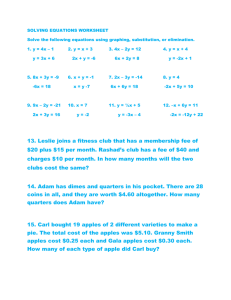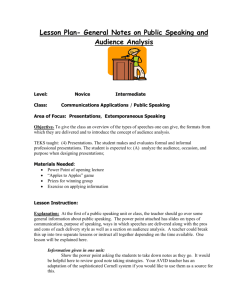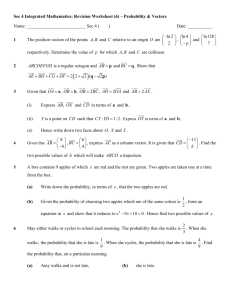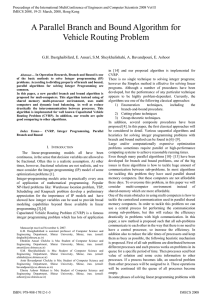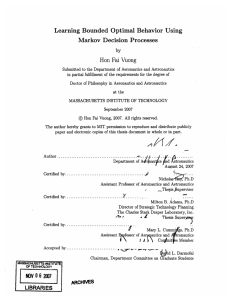first part
advertisement
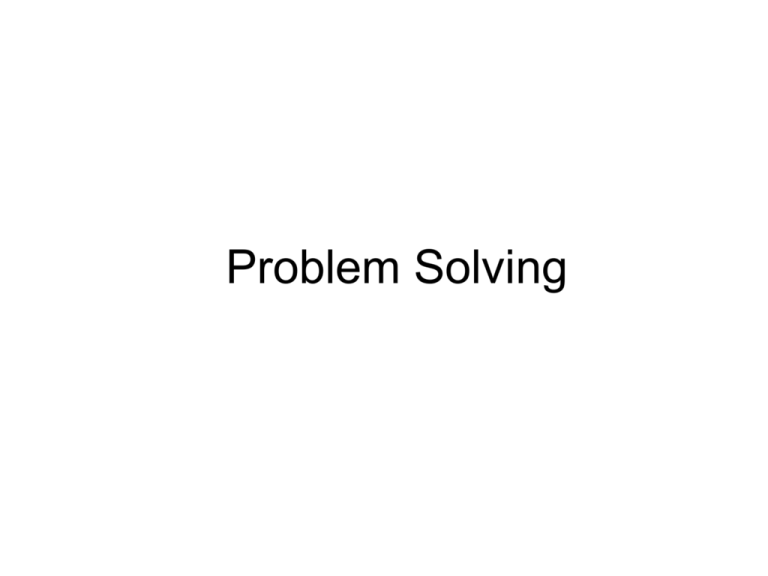
Problem Solving How to solve a problem? • • • Programming is a problem-solving activity. If you are a good problem solver, you could become a good programmer. Problem-solving methods are covered in many subject areas: - Business students learn to solve problems with a systems approach - Engineering and Science students use the engineering and science methods - Programmers use the Software Development Method Software Development Method To solve a problem using a computer, you need to: • Think carefully about the problem & its solution - Analyze the problem - Specify the problem requirements • • • • Plan it out beforehand (write an algorithm) Check it over to see that it addresses the problem Modify the solution if necessary Use the outlines to write a program that you can run on a computer • Finally, the program is tested to verify that it behaves as intended. Introduction to Algorithms • The algorithm is the abstract idea of solving a problem. • An algorithm is a step-to-step problem solving process in which a solution is arrived at a finite amount of time. • The algorithm is written in an algorithmic language (or a pseudo code). Algorithms vs. programs • When an algorithm is coded using any programming language (e.g. C++), then it is called a program. • The program is a set of instructions that can run by the computer. Characteristics of Algorithms • • • It should be accurate: - It shouldn’t be ambiguous (each step in the algorithm should exactly determine the action to be done). It should be effective: - It shouldn’t include a step which is difficult to follow by a person (or the computer) in order to perform it. The algorithm should be finite: - the algorithm has to end up in a point at which the task is complete Flowchart • It is another way to display the algorithm. • It is composed of special geometric symbols connected by lines and contain the instructions. • You can follow the lines from one symbol to another, executing the instructions inside it. Flowchart Symbols • Start / End symbol • Input/Output symbol • Processing symbol • Condition & decision symbol • Continuation (connection symbol) • Links Problem Solving and Programming Strategy • Programming is a process of problem solving. • The problem is solved according to the problem domain (e.g. students, money). • To be a good problem solver and hence a good programmer, you must follow good problem solving technique. One problem solving technique to solve the problem includes - analyzing the problem & outlining the problem’s requirements, - designing steps (writing an algorithm) - implementing the algorithm in a programming language (e.g. C++) and verify that the algorithm works, - maintaining the program by using and modifying it if the problem domain changes. (a) Problem Analysis 1- Thoroughly understand the problem 2- Understand the problem specifications. 3- If the problem is complex, you need to divide it into sub-problems and repeat steps (1& 2). That is, you need to analyze each sub-problem and understand its requirements. Specifications can include the following: - Does the problem require interaction with the user? - Does the problem manipulate data? What is the input data & how it is represented? - Does the problem produce output? How the results should be generated and formatted. - What are the required formula for solution - Is there any constraints on problem solution? • An Example for Problem Specifications: Problem Statement: Determine the total cost of apples given the number of kilos of apples purchased and the cost per kilo of apples. We can summarize the information contained in the problem statement as follows: • Problem Input: - Quantity of apples purchased (in kilos) - Cost per kilo of apples (in dinars per kilo) • Problem Output: - Total cost of apples (in dinars) • Formula: Total cost = Number of kilos of apples × Cost per kilo (b) Algorithm Design and Testing • Design an algorithm for the problem. • If the problem is divided into smaller sub-problems, then design an algorithm for each sub-problem. How to write an Algorithm? An algorithm is a sequence of statements to perform some operations. You can write an algorithm with the following layout: ALGORITHM algorithm_name statements of algorithm END algorithm_name • The algorithm would consist of at least the following tasks: 1- Input (Read the data) 2- Processing (Perform the computation) 3- Output (Display the results) Structured Design: Dividing the problem into smaller sub-problems is called “structured design”, “top-down design”, Structured Programming: In the structured design - The problem is divided into smaller sub-problems - Each sub-problem is analyzed - A solution is obtained to solve the sub-problem - The solutions of all sub-problems are combined to solve the overall problem. This process of implementing a structured design is called “structured programming” Testing the Algorithm: - You need to check the algorithm for correctness - Use sample data for algorithm testing (c) Coding • Coding: - After verifying that the algorithm is correct, you can code it in any high-level programming language - The algorithm is now converted into a program (d) Executing the Program • Compile the program (to check for syntax error) • Run the program. If the execution doesn’t go well, then reexamine the code, the algorithm, or even the problem analysis. Advantages of Structured Programming • Easy to discover errors in a program that is well analyzed and well designed. • Easy to modify a program that is thoroughly analyzed and carefully deigned.

